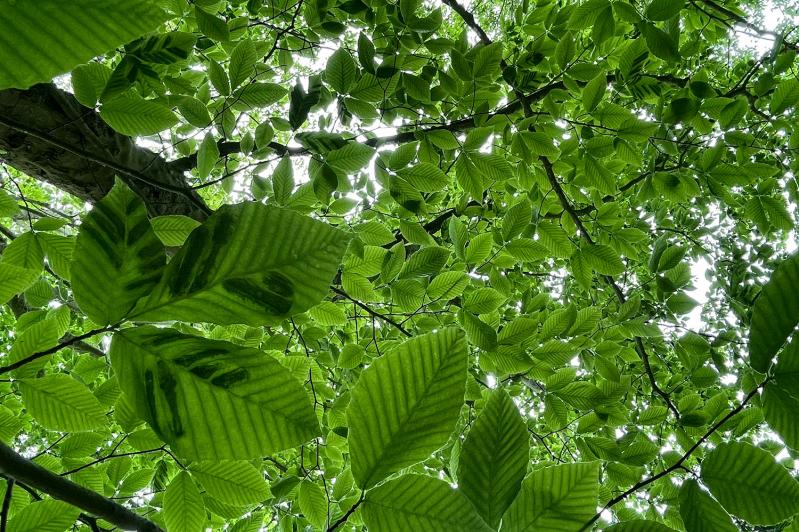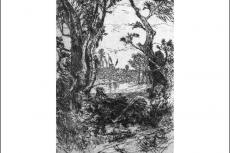A microscopic wormlike creature is rapidly killing American and European beech trees on the East End, and there is not much to be done about it. The pest, a nematode, causes beech leaf disease, or B.L.D., and it is affecting trees from northern Virginia to Maine.
According to Margery Daughtrey, a plant pathologist at the Long Island Horticultural Research and Extension Center in Riverhead, it appears to have started in the United States, in Ohio, sometime before 2012. By 2019, it was on Long Island.
Albert Intreglia, a Northwest resident, noticed it first in his copper beech tree. “It was not leafing out as fully and quickly as it should,” he said. “Last year it was perfectly healthy. Forget the financial toll this might take, it’s the emotional toll. These are prized trees,” he said.
According to the New York Department of Environmental Conservation, “this disease has only been discovered in recent years and much about it, including the full cause and how it spreads, is unknown.” Because it is so new, there is no official plan in East Hampton Town to address it, said Andy Gaites, the principal environmental analyst in the town’s Land Acquisition Department.
The D.E.C. says the disease can kill mature beech trees in 6 to 10 years and younger trees even more quickly. While this is a horticultural issue, meaning that many people plant or have ornamental beech trees on their property that they value for beauty, it is also a forestry issue. Beech is a common forest species across the state and is an important host for bird nests. Beech trees also provide food for birds, black bears, and other wildlife.
Matt Hartline, a board-certified master arborist at Bill Miller and Associates in Water Mill, said that because so many people have beloved beech trees on their properties, the disease is hitting home at a different level from the devastating southern pine beetle infestation, which was discovered late in 2017 and has wiped out large swaths of pitch pines in East Hampton, Wainscott, and Amagansett. Ornamental beech trees are often the centerpiece trees on a property.
The generic name of the disease belies the mysterious nature of the pathogen. “The initial symptoms in a year-one infection are extremely subtle,” he said. “To spot the interveinal banding, the discoloration in the veins of a small percentage of the trees’ canopy is like looking for a needle in a haystack.”
One thing people can do to check for the disease, he said, is “stand with your back to the trunk looking at the underside of the foliage.” If the sunlight is above and filtering through the tree leaves, you may be able to see “striping between the veins of the leaves.”
Striping indicates the nematode “already has a foothold and has been there a while,” said Ms. Daughtrey. More advanced disease symptoms include stunted leathery leaves or leaf buds that don’t open at all.
Jackson Dodds, an arborist and tree surgeon, agreed and said it is “extremely important for people to get an arborist on site” to assess the condition of their beech trees. He said the disease was “tremendously upsetting” and that “not knowing how to treat it has been the hardest thing for arborists.” He said larger trees may fare better because they have more energy reserves to tap into should the disease cause them to defoliate.
The nematodes spend the growing season inside the tissue of the leaf, said Mr. Hartline, and undergo multiple generations just within the span of a growing season. That is why, once it infects a tree, the deterioration can happen so quickly; the nematode population builds up fast. Ms. Daughtrey said that “fallen, windblown leaves could move it from one area to another” but it is a mystery how the little nematodes get up the trunk and to the canopy above. Infected nursery stock could also move it between states. “Short-distance spread is assumed to be via wind-driven rain,” she said.
As for treatment, everything is experimental and there are no proven “cures” she said. Scientists have experimented by treating infected trees with a phosphorous fertilizer, while another treatment involves spraying a fungicide onto the trunk of the tree. Neither kills the nematodes directly but each helps build the tree’s immune response and could help it defend itself. What they hope for is to gain some time until a true cure is found. “I am still feeling slightly optimistic about treatment efforts, even though there are none yet that achieve miraculous effects,” said Ms. Daughtrey.
Mr. Hartline said “arborists are offering a wide variety of experimental treatments” at the moment but the best thing people can do right now is to “make a healthy environment for your tree.” If we get a drought this year, keep it watered. Add organic matter to the soil. These sorts of things can help a tree’s performance in general, he said.
Until a cure is found, he had this suggestion for those worried about the disease. “Enjoy your trees. Understand that they are living organisms and they have finite life spans.”




